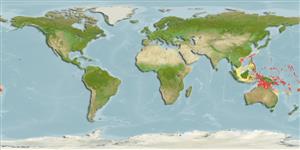>
Gobiiformes (Gobies) >
Gobiidae (Gobies) > Gobiinae
Etymology: Trimma: Greek, trimma, -atos = something crushed (Ref. 45335); preclarum: From the Latin word 'preclarus' meaning splendid ro very beautiful, referring to its color when alive, especially the multi-hued iris.
More on author: Winterbottom.
Environment: milieu / climate zone / depth range / distribution range
Ecologia
marinhas associadas(os) a recifes; intervalo de profundidade 10 - 60 m (Ref. 90102). Tropical
Western Pacific: Fiji, Palau, Papua New Guinea, Solomon Is., and photographed underwater in Saipan.
Tamanho / Peso / Idade
Maturity: Lm ? range ? - ? cm
Max length : 2.0 cm SL macho/indeterminado; (Ref. 57544)
Descrição suscinta
Chaves de identificação | Morfologia | Morfometria
Espinhos dorsais (total) : 7; Raios dorsais (total) : 9; Espinhos anais: 1; Raios anais : 8 - 9. Diagnosis: This species is characterized by the presence of predorsal scales; second and third dorsal-fin spines elongate; moderate interorbital and postorbital trenches; no opercular scales; and, scales across the top half of the body outlined with pigment. The fifth pelvic fin ray is branched sequentially once or unbranched depending on the capture location and living specimens has three yellow stripes extending along the body, two stripes in the dorsal and anal fins (one dark and one yellow) and a red or cerise iris with four large, irregularly-spaced yellow spot (Ref. 57544); characterized further by having longitudinal scale series 22-24; predorsal scales 6-9; depth of body about 4.2-4.4 in SL (Ref. 90102).
Collected from a drop-off wall with a few small caves, coralline algae, antipatherians and numerous hard corals (Ref. 57544). Inhabits reef walls and rubble in 10-60 m (Ref. 90102).
Ciclo de vida ou comportamento de acasalamento
Maturidade | Reprodução | Desova | Ovos | Fecundidade | Larvas
Winterbottom, R., 2006. Two new species of the gobiid fish Trimma from the coral reefs of the western Pacific Ocean (Pisces; Perciformes; Gobioidei). Zootaxa 1331:55-68. (Ref. 57544)
Status na Lista Vermelha da UICN (Ref. 130435: Version 2024-2)
Ameaça para os humanos
Harmless
Uso pelos humanos
Pescarias: sem interesse
Ferramentas
Relatórios especiais
Baixar XML
Fontes da internet
Estimates based on models
Preferred temperature (Ref.
123201): 26.1 - 28.9, mean 27.9 °C (based on 170 cells).
Índice de diversidade filogenética (Ref.
82804): PD
50 = 0.5000 [Uniqueness, from 0.5 = low to 2.0 = high].
Bayesian length-weight: a=0.01023 (0.00477 - 0.02194), b=3.01 (2.83 - 3.19), in cm total length, based on LWR estimates for this (Sub)family-body shape (Ref.
93245).
Resiliência (Ref.
120179): Elevada, tempo mínimo de duplicação da população menor que 15 meses (Preliminary K or Fecundity.).
Fishing Vulnerability (Ref.
59153): Low vulnerability (10 of 100).
Nutrients (Ref.
124155): Calcium = 422 [175, 1,489] mg/100g; Iron = 1.96 [0.82, 4.41] mg/100g; Protein = 18 [16, 20] %; Omega3 = 0.183 [0.056, 0.600] g/100g; Selenium = 39.2 [11.2, 113.7] μg/100g; VitaminA = 107 [20, 547] μg/100g; Zinc = 4.93 [2.58, 8.37] mg/100g (wet weight);
